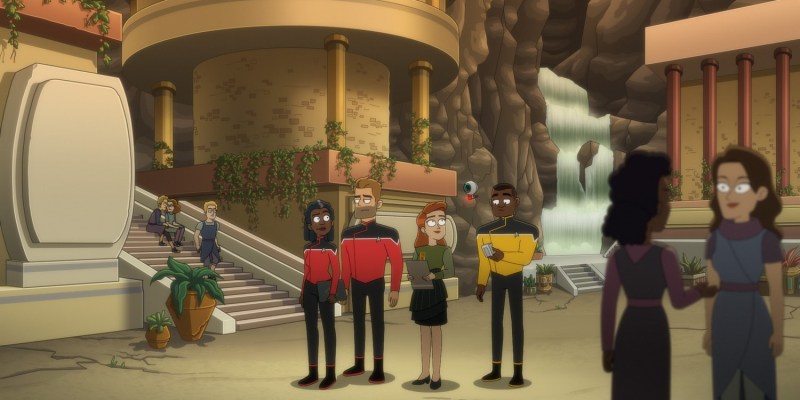This discussion and review contains spoilers for Star Trek: Lower Decks season 3, episode 9, “Trusted Sources.”
It has been interesting to watch Lower Decks slowly build its internal continuity across its first three seasons. Indeed, “Trusted Sources” often seems to be about how the series has gradually but consistently built its own internal mythology, with recurring characters and long-form arcs.
Lower Decks is obviously heavily and specifically indebted to The Next Generation, with showrunner Mike McMahan first engaging with the franchise through a Twitter account pitching goofy ideas for a hypothetical eighth season. More broadly, as a show set on a starship engaged in a series of weekly episodic missions, Lower Decks feels like an extension of the dominant form of 1990s-era Star Trek, which ran from The Next Generation into Voyager and even the first two seasons of Enterprise.
Of course, these shows were not entirely without continuity. There were certain long-form character and narrative arcs that played out in the background, such as the internal politics of the Klingon Empire on The Next Generation or the evolving relationship between Tom Paris (Robert Duncan McNeill) and B’Elanna Torres (Roxann Dawson) on Voyager. However, by and large, episodes of these shows were largely self-contained, often to the frustration of writers like Ronald D. Moore.
Lower Decks hasn’t really developed any sense of an external continuity. It is difficult to get a sense of what the Star Trek universe actually looks like in this gap between the end of the Dominion War at the conclusion of Deep Space Nine and the isolationist Starfleet introduced in Picard. There is no sense of what the Romulan Empire looks like after Star Trek: Nemesis. Is Cardassia under Federation occupation? Outside of hints in “wej Duj,” it is unclear what is happening within the Klingon Empire.
While this lack of specificity was a problem when the show tried to wade into the aftermath of the Dominion War in “Hear All, Trust Nothing,” it overlooks the extent to which Lower Decks has managed to construct a fairly consistent and compelling internal continuity. The show’s episodes are mostly self-contained and accessible to casual audiences, but there is also a strong sense that the events of these seemingly isolated adventures can mount and build.
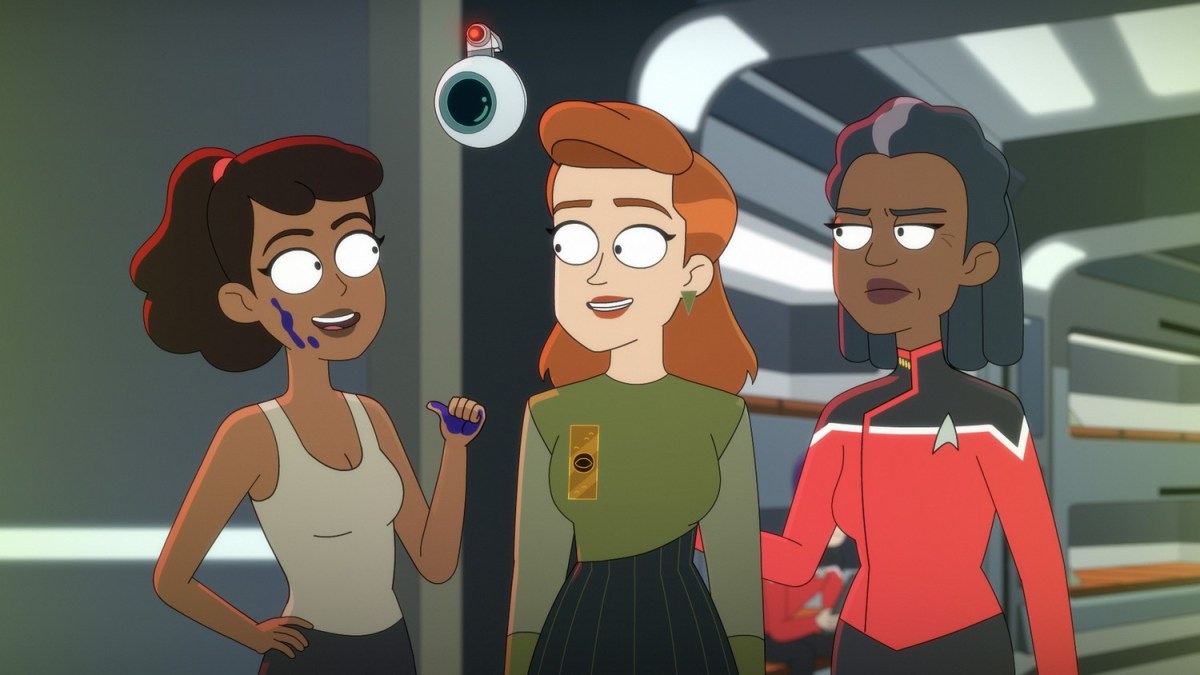
This is evident in a variety of ways. To pick one small example, Lower Decks leans into low-key recurring jokes that build slowly over time. In “Grounded,” it is established that Brad Boimler’s (Jack Quaid) family runs a raisin vineyard, in which grapes are dried to make raisins. However, the show implies that he may actually be a raisin. With his purple hair, it is ironic that Boimler himself is frequently dehydrated in episodes like “I, Excretus” and “Crisis Point 2: Paradoxus.”
In particular, the third season has returned repeatedly to the absurdity of the “wellness-based” cultures that popped up in early seasons of The Next Generation, in episodes like “Justice” or “Haven.” Lower Decks visits such cultures in “The Least Dangerous Game” and “Room for Growth.” As such, it is a clever punchline in “Trusted Sources” when it is revealed that Ornara, another planet from an early episode of The Next Generation, has evolved into a “wellness-based” culture.
However, it is more than just jokes. Character arcs play out over long periods. “A Mathematically Perfect Redemption” picked up on the fate of guest character Peanut Hamper (Kether Donohue) a season and a half after her only previous appearance in “No Small Parts.” Vice Admiral Buenamigo (Carlos Alazraqui) has become a recurring guest star during the season. Showrunner Mike McMahan has promised that the character of T’Lyn (Gabrielle Ruiz) from “wej Duj” will return to the show.
Indeed, the third season of Lower Decks has gotten a bit more confident about this. The fifth episode of the season, “Reflections,” set up two plot points clearly designed to boomerang later in the season. Petra Aberdeen (Georgia King) returns at the end of “Trusted Sources,” delivering the payoff to her setup. It seems more than likely that the mystery around Samanthan Rutherford’s (Eugene Cordero) lost memories will come into play either in the finale or during the fourth season.
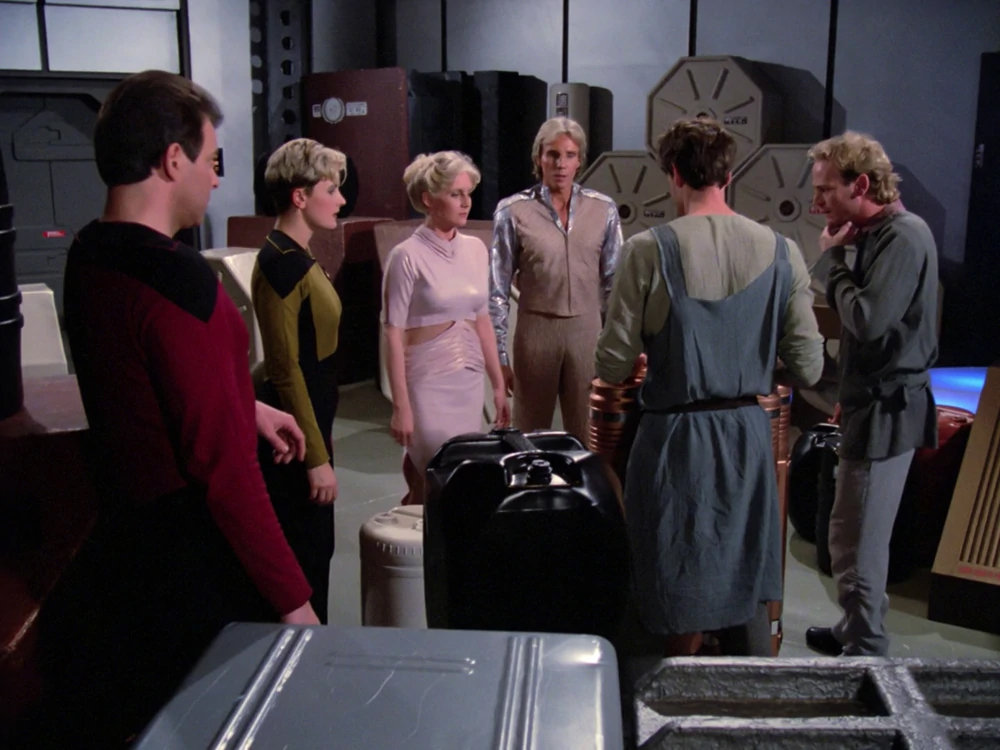
In some ways, “Trusted Sources” is about this evolving sense of continuity. Most obviously, the episode’s climax finds FNN reporter Victoria Nuzé (Alison Becker) weaponizing continuity against Captain Carol Freeman (Dawnn Lewis). Nuzé attacks Freeman by citing the events of earlier episodes like “Strange Energies,” “Kayshon, His Eyes Open,” “An Embarrassment of Dooplers,” “Room for Growth,” and “Hear All, Trust Nothing.” There’s even a reference to Q’s (John de Lancie) appearance.
“Trusted Sources” is also about continuity in a broader sense. It opens with Freeman proudly announcing that Starfleet has signed off on her proposal for “Project Swing-by,” an extension of the “second contact” brief that would see Starfleet checking in on societies they’d already contacted. It’s essentially about building a continuity in Starfleet’s relationship to these cultures. The Cerritos’ first mission is Ornara, the planet from the early Next Generation episode “Symbiosis.”
While on their way to Ornara, Freeman and Ransom (Jerry O’Connell) run through the events of “Symbiosis,” which was a heavy-handed parable about drug abuse in which Jean-Luc Picard (Patrick Stewart) found himself torn between two planets caught in a cycle of addiction. Ransom reads from the report. “Picard severed communication between the planets and… uh… let’s see… oh, then he left,” he reads. “Yeah, that’s… hoo… that’s how it went down.”
There is something unsettling in the idea that Starfleet simply never bothered to check on Ornara and its neighbor Brekka after Picard made such a radical decision with such far-reaching implications. “Seriously?” Freeman sighs. “So now it’s our job to check in on a whole planet that Picard left cold turkey?” Freeman is being characteristically self-centered, but she does have a point. The episodic nature of The Next Generation allowed the show to avoid complicated consequences.
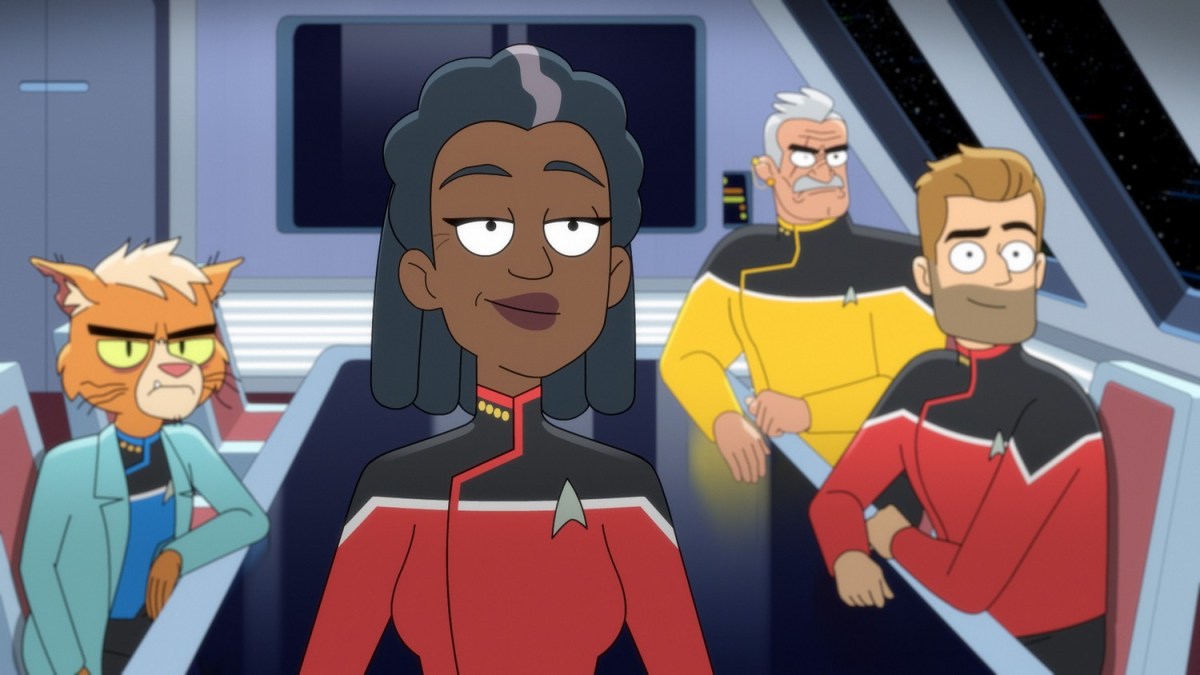
This is not a new or radical idea, even within the context of the larger Star Trek franchise. During its second season, as it was beginning to experiment with long-form serialization, Deep Space Nine built the episode “Crossover” around a similar premise. In that episode, Kira (Nana Visitor) and Bashir (Alexander Siddig) find themselves visiting the mirror universe decades after Kirk (William Shatner) set in motion the collapse of the Terran Empire in “Mirror, Mirror.” The results were not pretty.
While the mirror universe episodes of Deep Space Nine are something of a mixed bag, “Crossover” is a genuine masterpiece. It is an episode that is a scathing criticism of both the limits of rigid episodic storytelling when it comes to exploring consequences of characters’ choices, as well as a critique of casual interventionism by those who have no stake in the outcome. Of course, Deep Space Nine could do that because it was willing to engage with and challenge the underlying assumptions of Star Trek.
Lower Decks is far too reverential to mount a similarly bracing critique of Picard and the Enterprise. When Freeman beams down to Ornara, she discovers that the planet is in “a good place.” Nuzé suggests that Freeman’s attempt to find a worthy candidate for “Project Swing-by” is “a dud.” The locals have built a paradise. “Picard was absolutely right,” explains Local Magistrate B’Nir (TBD), as if talking about a stern parent. “It was the best thing that ever happened to us.”
To give “Trusted Sources” some credit, there are none-too-subtle implications that Picard wasn’t entirely correct in how he did what he did, even if the episode can’t directly articulate them. “We were in a bit of a bad place for the first ten/fourteen years, but we figured it out!” B’Nir explains, showing a mural that depicts the planet’s nightmarish descent into anarchy and violence. Throughout the scene, that mural is framed to focus on that decade Ornara spent in its “bad place.”
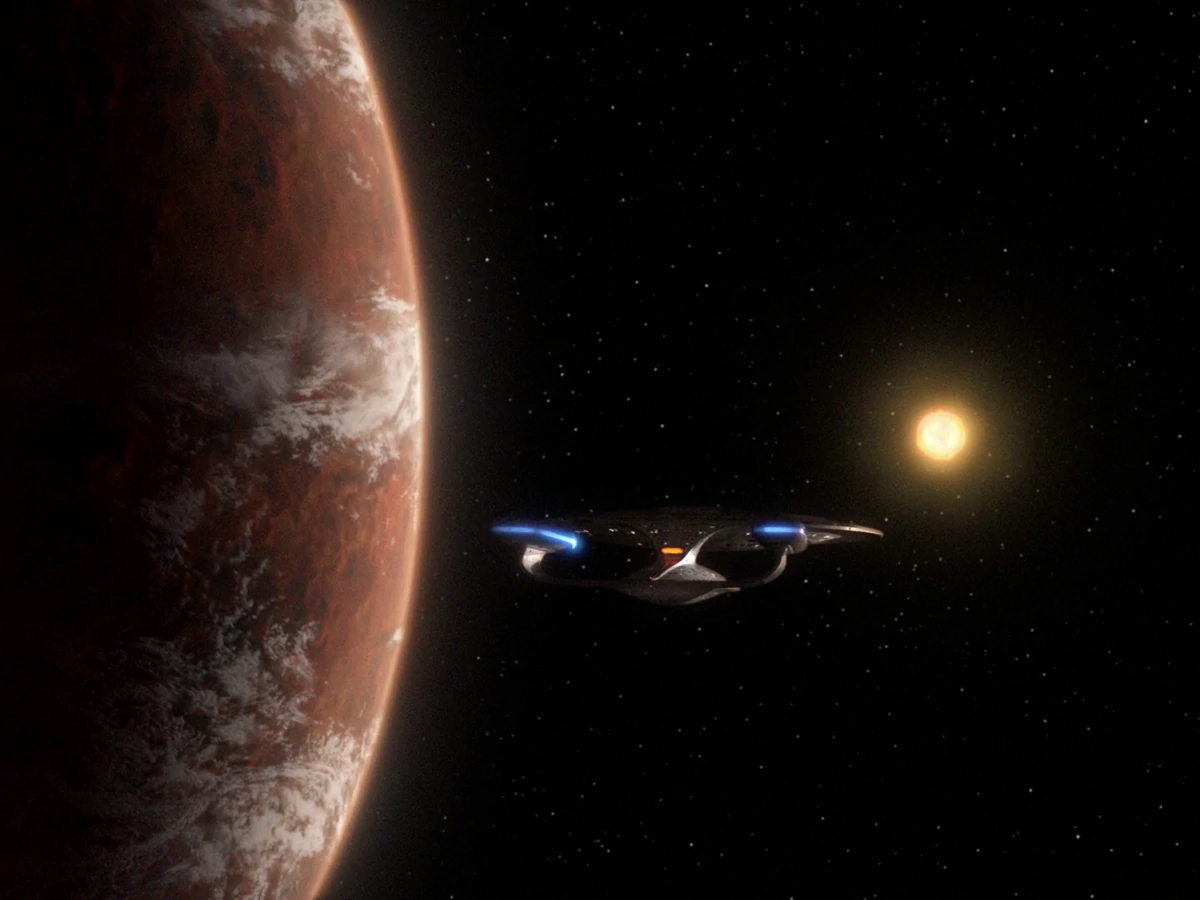
In fact, there is some implication that Ornara still carries some scars of that trauma. The sound of the name “B’Nir” suggests a “veneer” or façade. He jokes about how the planet has substituted one addiction for another. The planet also (understandably) wants nothing to do with Starfleet. He rejects Freeman’s offer of assistance. “Yeah, we’re good,” he counters. “Starfleet’s done enough for Ornara. There’s really no need for this visit.” It feels almost passive-aggressive.
That said, “Trusted Sources” ultimately suggests that “Project Swing-by” has some merits. The crew stop by Brekka, the nearby “pusher planet.” In a nice touch, Brekka is animated in shades of purple and populated with palm trees. It underscores the sense in which Brekka is a product of the late 1980s. It is designed like it’s a planet based around Miami Vice. On Brekka, the crew discover a problem: The Breen have occupied the planet.
The choice of the Breen is interesting, because it ties back to this sense of growing continuity. The Breen began as what writer Robert Hewitt Wolfe described as “sort of a running joke” on Next Generation in episodes like “Hero Worship” and “The Loss.” However, entirely accidentally and over time, they became major players in the final stretch of Deep Space Nine. The Breen are the perfect example of how continuity builds gradually over seasons of Star Trek.
This feels deliberate, as if Lower Decks is making an argument for its own internal continuity. “Trusted Sources” finds the Cerritos subject to external scrutiny, with an exposé on FNN branding it “Starfleet’s Shame.” It feels like meta-commentary on the subset of fandom who don’t consider Lower Decks to be “real Star Trek” because it is silly or because it is animated. Nuzé could be quoting from angry message boards when she uses terms like “chaotic,” “irresponsible,” and “silly.”
“Trusted Sources” is obviously gearing up for the Lower Decks season finale, but it’s also an endearingly assured piece of Star Trek. Three seasons in, Lower Decks has built its own corner of the Star Trek universe, and it is just enjoying getting to play in it.
